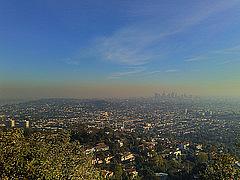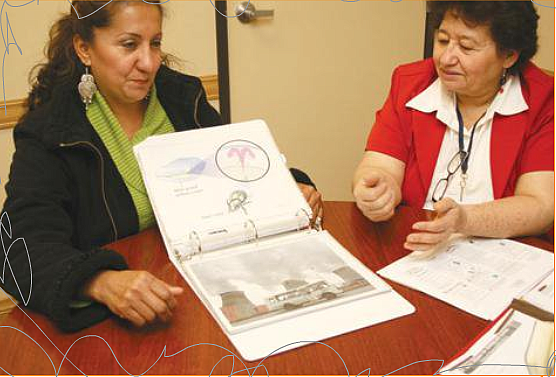In the air: Teenage lungs
What is air pollution doing to our kids? If you live in L.A. County, and especially if you've driven back to the Los Angeles basin from somewhere else, you've seen it. A steely brown haze hangs over us for much of the year. We live in the smoggiest region in the United States, but for those raising children here, that may not be top of mind. In some parts of the county, moms claw their way onto waiting lists for the "right" preschool while they are still pregnant. Concerns about finding the right neighborhood, the right school, about keeping kids away from gangs and drugs or getting them to turn off the Xbox and do some homework tend to take center stage. The air we breathe gets plenty of media coverage, but we tend to consider it more of an inconvenience than an emergency.
Yet at every stage of children's lives – from their time in the womb until they're ready to leave the nest – the pollution in the air impacts their health. 2010 California Health Journalism Fellow Christina Elston reports.


Silveria Romero and Nacira Torres worry about pollution's impact
Lee Outlaw was near the end of an 800- meter race last season, running for the Manual Arts High School Toilers track team. Suddenly, he went down, collapsed flat onto the track. “Out of nowhere he just had no air,” says his mother Rolanda Richard, who was watching from the bleachers that day.
Outlaw is 16, a junior at Manual Arts, and has had asthma since he was a baby. He got so used to going to the hospital for steroid shots to help him breathe that they didn’t even make him cry. He says that when he started high school, the chance to play sports – track and basketball, and his true love, football – motivated him to get his asthma under better control, to take his medication on schedule. Before that? “It was painful because I was always going to the hospital,” says Outlaw. “And if I wasn’t in the hospital, I would be at home sick.”
Manual Arts is barely half a mile from the Harbor Freeway in South Los Angeles. Outlaw plays running back and corner back there, and at least five other players on the football team have asthma. Some have to bring their nebulizer machines onto the sidelines during games. But Outlaw says his asthma is better controlled now. He uses his FloVent inhaler every day, and Albuterol when his asthma acts up, usually when he gets sick.
That is in large part due to the efforts of Vanessa Neal, M.D., one of the pediatricians at nearby St. John’s Well Child & Family Center. Neal, who sees about 500 patients a month at St. John’s, says asthma can definitely get in the way of what a teen wants to do, “especially the kids that are really active.” Experts are increasingly trying to get kids off the sidelines to combat burgeoning childhood obesity rates, but asthma can interfere with sports – and sleep, and schoolwork.
It’s one of a host of breathing problems that can plague teens living and learning near L.A.’s vast network of freeways – and these problems can follow them throughout life. With traffic cris-crossing into every corner of SoCal, few families in any part of town are immune to the risk.
Kids’ lungs experience a major growth spurt between fourth grade and high school graduation. Boys’ lungs during that time grow an average of 115%, while girls’ grow roughly 70%. “It’s a very steep growth curve, and it’s very much timed with puberty,” says Jim Gauderman, Ph.D., USC professor and expert in the long-term effects of pollution on children’s lungs. And once that spurt is over, kids don’t get another.
For kids ages 10-18 years old, “we see about a 5-1/2% drop in that growth on average for kids who live in polluted communities,” says Gauderman. For children who live near freeways, the drop in lung growth averages 4%. And for children who live near freeways in polluted communities, it is 9-1/2%.
You wouldn’t know it to look at Christopher White, another of Dr. Neal’s patients, who boxes (says he is undefeated after a year’s worth of bouts) and boasts that he now weighs in at 200 pounds. The 17-year-old senior at Opportunity High School, an LAUSD charter, was diagnosed with asthma at age 12, and struggled for years. “My body was slowed down,” he says. “Breathing was complicated during the night time.” Now he hopes to head to UCLA after graduation to become a phlebotomist (medical technician who draws blood). “I can breathe,” he proclaims.
White has only been a patient at St. John’s for about a month, and there has been a big turnaround in his symptoms. His grandmother Doris Marks is delighted with the new medication Dr. Neal has prescribed. She says White’s color is a lot better now. “I could hear him when he’d start to have that breathing,” she says. “You know that sound.”
Gauderman, as lead investigator in the Children’s Health Study led by USC, has been studying the impact of pollution on teens’ breathing since 1993. And in the past decade his team, along with a host of other air pollution experts, have zeroed in on tiny particles in vehicle exhaust as a major threat. They have followed the lung development of thousands of children, and are currently working with 5,000 middle schoolers.
Drilling down further, Gauderman and colleagues recently spent about a year sampling air near the children’s homes, to monitor the particulate matter they are exposed to. And after almost two years of chemical analysis and crunching the numbers, they will soon have data on the health effects of ultrafine particles and the chemicals they can draw into the body.
Many of the problems that get in the way of breathing for St. John’s patients, however, are more readily visible. Silveria Romero and Nacira Torres from the Compton Asthma Case Management program – a collaboration of the Long Beach Alliance for Children With Asthma and The Children’s Clinic in Long Beach – often work with families from St. John’s. They make home visits to teach families how to deal with the mildew and pests that can trigger attacks, hand out mattress and pillow covers to keep dust mites at bay, and make sure patients and parents know how to use the inhalers and nebulizers that deliver their medications.
“We cannot do anything about the pollution,” Romero says, shrugging at a photo of a trademark hazy L.A. sky among the program’s educational materials. But they do advise kids to use their inhalers before going outdoors on “bad air” days.
These efforts, plus the right medications, can help teens breathe easier. Lee Outlaw once had to join the basketball team behind his mother’s back because she was afraid too much exercise would trigger asthma attacks. Now his coaches carry a spare inhaler for him, and he hopes to play football for the University of Oregon after graduation.
But what about farther down the road? Gauderman says that at age 18, a person has the best lung function they will ever have. And after our early 20s, we lose lung function as we age. Starting adulthood with a deficit, and no way to make it up, could mean greater risk of heart disease and other health problems.
After Outlaw went down on the track that day, he got back up. But he doesn’t run the 800 meters any more. Education and medication can get kids only so far. “We’re probably going to have to start thinking more globally about air quality,” says Gauderman. Kids need healthy lungs to go the distance.

